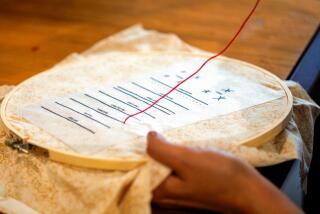So Chic, Sew Now: Jeans by . . . You
- Share via
Instead of forking over hundreds of dollars for the same Bohemian-inspired jeans and thong sandals everyone else is wearing, why not make your own? With a few fabric remnants, some inexpensive trim and a little creativity, you can update a pair of old jeans and make plain sandals trendy for the summer.
Handmade fashions have become a major trend, and according to the Home Sewing Assn., a number of fashion-forward people are creating their own designer looks, often at significant savings. Joan Campbell, executive vice president of the group, says that sewing offers an opportunity for self-expression.
“More and more people, especially young people, are looking for this kind of creative outlet,” Campbell says.
Others find sewing a stress reducer. And today, computerized sewing machines make customized embroidery and appliques--signature elements of the Bohemian look--easy.
But customizing your jeans doesn’t have to involve sewing. Vesna Vucetic from Jo-Ann Fabrics & Crafts in Torrance showed us how to give an old pair of Levi’s the hippie treatment using only iron-on adhesive and a craft and fabric glue.
The project takes about two hours and may require some practice. But remember, the good thing about the Bohemian look is that it is supposed to appear handmade. Don’t worry about exact measurements or having colors and patterns match up. A patchwork effect is a good thing.
Here’s what you’ll need: assorted fabric remnants and ribbons, iron-on appliques, rickrack trim, a craft and fabric glue like Fabri-Tac Permanent Adhesive, a lightweight iron-on adhesive like HeatnBond Iron-on Adhesive Lite, iron and ironing board, a large surface area to work on, scissors, measuring tape, needle and thread, beads and feathers.
You may want to use material from old clothes, or hit the flea markets for interesting fabrics and ribbons. All trims and appliques we used cost less than $3 each, including bags of beads and feathers. Glue costs about $6 a bottle, and sheets of adhesive paper and rolls of adhesive tape are just a few dollars.
Step 1: Preheat iron on dry heat setting. Measure the circumference of your jeans leg at the hem. Cut fabric remnants into strips a little longer than that. Our jean legs were 18 inches around, so we cut fabric remnants into 19-inch-long strips. The width of fabric strips does not matter. We made ours about 5 inches wide. Cut all trims, such as ribbons and rickrack, into 19-inch strips as well.
Step 2: Place fabric strips wrong side up on ironing board. Fold the two long edges of the fabric in about a quarter-inch each. Use iron to press the folds flat. (Folding the edges in prevents the fabric from fraying after it is affixed to jeans.) Fold one of the fabric’s short edges in a quarter-inch and press. Repeat Step 2 for each strip.
Step 3: Lift the quarter-inch fold, place dabs of glue on the inside of the fold, and press down to seal. Fabri-Tac glue is great because it dries clear and fast. But beware, since it’s acetone-based, it wreaks havoc on manicured nails. (Double-face sewing tape, which must be ironed to seal, may be used instead of glue.) Turn fabric strips right side up and put aside to dry. Repeat with every fold on remaining strips of fabric.
Step 4: Adjust iron’s setting to silk. Now you should have four to five strips of fabric for each jean cuff. Each strip should have only one frayed edge exposed. The other three edges (two long and one short) should be folded in and secured with glue or sewing tape. Arrange the strips next to each other as you want them to appear on your jean cuff. Place them wrong side up on the ironing board. Make sure each strip overlaps slightly, and that frayed edges are aligned. (Don’t worry about ribbons and rickrack at this point. Those can be applied with glue later.)
Step 5: Cut a piece of HeatnBond adhesive paper to fully cover the fabric strips. (Note: You want your piece of adhesive to be a little smaller than the fabric’s area; otherwise, you may accidentally attach the fabric to the ironing board cover.)
Step 6: Place HeatnBond paper with shiny textured side down on the wrong side of the fabric. Glide iron across the HeatnBond paper for one to two seconds.
Step 7: Allow fabric to cool, then peel off paper backing. Adhesive should appear milky in color. Shiny, clear adhesive is a sign of overheating. Place fabric right side up on the cuff in the desired position beginning and ending at the inseam. Iron fabric onto jeans for three to five seconds.
Step 8: At the inseam, join the two ends of the fabric piece. Make sure the end with the neat folded edge overlaps the frayed one. Secure with glue. Let dry. The fabric piece should now be affixed on the jean cuff. For more embellishment, glue rhinestones, beads, rickrack or ribbon onto the fabric cuff. Iron on flower and flag appliques.
People will be asking you where you got your jeans. They asked about ours.
* For more help, consult the Home Sewing Assn. at https://www.sewing.org. The Web site links to many large sewing and craft stores and includes free projects, tips and trends.
* Booth Moore can be reached by e-mail at booth.moore@latimes.com.







